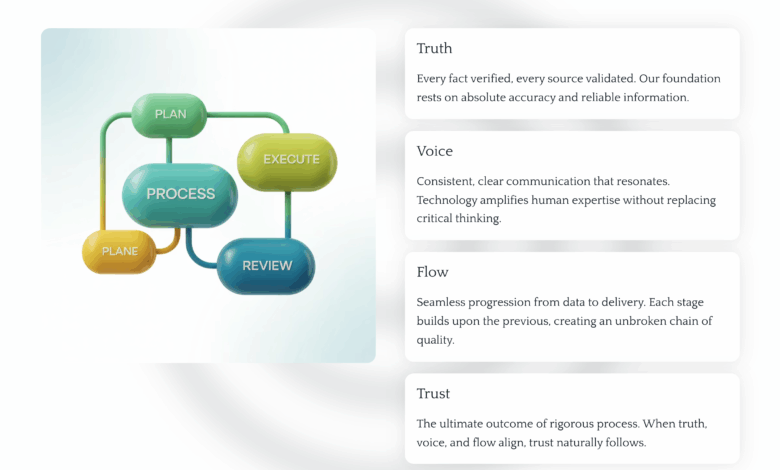
The AI headlines are breathless, but a quieter story keeps surfacing in boardrooms: pilots stall. As recent reporting on State of AI in Business 2025 highlights, many enterprise initiatives never make it to reliable, day-to-day use. In my work with AI and SaaS companies, the culprit is rarely the model. It’s the handoff to the business: no single source of truth for facts, scattered approvals, and workflows that privilege speed one week and accuracy the next. The result is predictable: drafts multiply, trust wobbles, momentum fades.
We’ve treated AI as an IT project when, in practice, it’s a communications problem. Not communications as in “press release,” but communications as infrastructure: how facts are maintained, how tone is governed, how drafts move, and how the public record is kept credible and current. Until businesses design that layer, pilots will continue to pile up in the graveyard of good intentions. A complementary datapoint: S&P Global found the share of companies scrapping most AI initiatives jumped from 17% to 42% year-over-year; classic signs of pilot purgatory.
Consider a recent (anonymized) SaaS case. Support sees a pattern in tickets after a minor outage. Product updates the runbook. Marketing drafts reassurance. Legal wants caveats. The CEO needs a note for key accounts. Everyone is right, and everyone is late. The company issues three different versions of the same truth within 24 hours. Reporters notice. So do customers. No model can fix that. Only a system can.
The system I’m arguing for isn’t heavy; it has just four ideas at its core. None of them exotic, all of them neglected.
Truth. Most firms don’t maintain a living, public-facing inventory of their own approved facts: boilerplates in a few lengths, short and long bios, product definitions and claims, lines-to-take on sensitive topics, and a simple “last updated” discipline. Without that inventory, every draft re-litigates yesterday’s decisions. With it, people and assistants can “look it up first, then write.” Accuracy stops being an act of heroism.
Voice. The fastest way to get burned by AI is to let it publish. The fastest way to get value is to let it draft — and stop there. Treat “agentic AI” like a capable junior who knows the tone rules, cites the sources it used, and never hits send. That one boundary restores speed without sacrificing judgment. In teams that get this right, approvals shrink to edits, and “first-pass approval” becomes a meaningful metric rather than a wish.
Flow. What kills momentum isn’t creativity; it’s handoffs. Mentions surface; someone summarizes; someone else routes; a draft needs an owner and a due date. These aren’t heroic tasks; they’re plumbing. Light automation (nothing more glamorous than a mention being summarized and tagged, dropped into Slack or Notion with an owner, then converted into a draft task) replaces the daily scavenger hunt with a predictable rhythm.
Trust. AI assistants increasingly answer stakeholder questions before your team ever sees them. They favor what people favor: credible, current, well-structured content. That means turning social sparks and internal notes into reference-grade articles on your site: clear authorship, real sources, a short FAQ, a “last updated” line. When those pages earn citations in op-eds, interviews, and niche blogs, you maintain a public record your stakeholders and machines alike can rely on.
Notice what I didn’t say: I didn’t prescribe a platform, a model family, or a vendor. This isn’t about shopping. It’s about accepting that communications is an operating system, not a press tactic. The organizations that mature their AI don’t have “centers of excellence” issuing memos from afar; they have communications architecture embedded in the work: a small facts library that’s actually maintained; assistants scoped to draft-only; a couple of boring automations everyone can explain; and reference pages that stand up to scrutiny.
The counter-argument, usually from well-meaning technologists, is that this undersells the magic. Why buy a sports car if you’re going to obey the speed limit? Because reputations don’t have airbags. The constraint (for ex agents draft, humans publish) is the condition for moving faster safely. When executives get a first draft that is on-tone, sourced, and routed, they stop word-smithing and start deciding. When Legal sees the same “source of truth” everyone else uses, it argues less and approves more. When Product knows that updates will propagate to the public record within hours, it stops hoarding information.
Leaders also ask, reasonably, how to measure any of this. You don’t need vanity metrics. Measure what changes operating reality: time-to-message (from detection to first, source-cited update); first-pass approvals (the share of drafts approved with one or fewer edits); correction rate (public corrections divided by public updates); and citation count (how often external articles reference your reference pages). Improve those, and the “pilot” label stops applying; because the organization has learned to communicate at the speed it builds.
None of this dodges risk. Confidential work still demands adult supervision: temporary chats with history off for sensitive drafting; minimal, masked details before launch; private libraries of approved facts instead of raw decks in prompts; logs that show who drafted what and why. Treat safety as a feature, not a footnote, and scale becomes possible. The teams that fear AI the least are the ones that govern it the most.
So where does this sit? With PR and communications, unapologetically. We already live at the intersection of story, product reality, and legal constraint. We own tone. We are accountable for clarity at speed. Designing the communications layer is our job, done properly in the age of AI.
Sophie Reymond runs SRPR, a Switzerland-based PR consultancy for AI/SaaS teams, combining senior PR craft with AI-ready communications systems across the EU and US. Connect on LinkedIn or visit srpr.ch.





